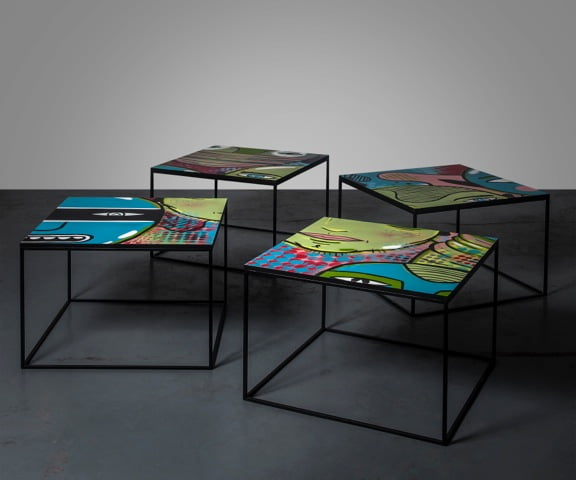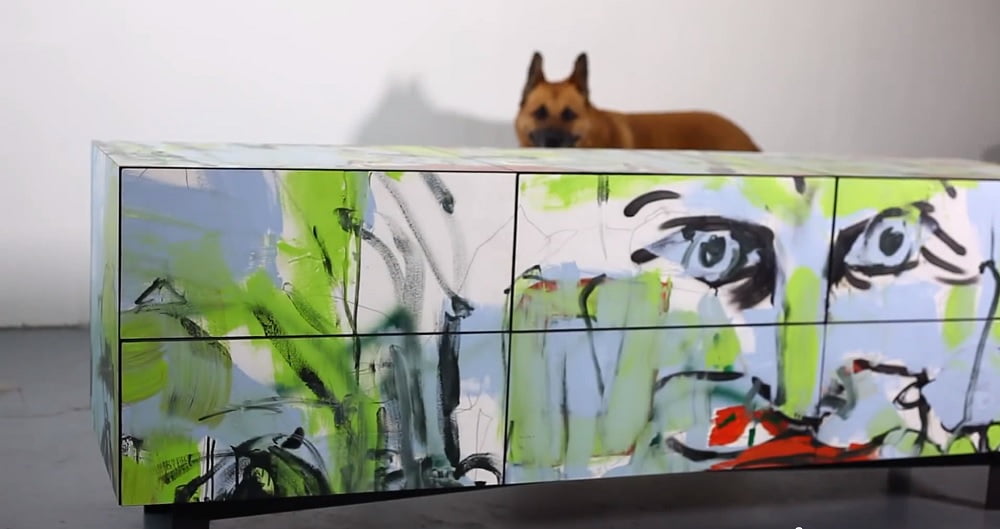Swathes of bright colored graffiti cover the walls, the smell of sawdust permeates the air, and the steady hum of hammers and saws ricochet off the walls down an old narrow alley tucked away in the southern Tel Aviv neighborhood of Florentin. Carpenter’s Alley, as its been called since the 1950s, is still home to many carpenters and artists and it’s where Ariel Zuckerman’s art studio is located. Its also where he and long time friend, Eran Shimshovitz got the inspiration for their project “Street Culture,” to turn alleyway graffiti into high-end furniture.
The project, which started out as a completely spontaneous endeavor, began just one year ago when Zuckerman and Shimshovitz had the idea to create a design that would combine the daytime hustle of nearby factories with the nighttime bustle of hip, young, and artsy Florentin. “Everyone creates furniture here, and we thought we would take what happens here in the day time, which is furniture making, and combine it with the nightlife, which amounts to lots of art and graffiti, showcasing the two very different worlds here,” explains Zuckerman, “sort of like the Jekyll and Hide of Florentin.”
Anonymous artists – the key ingredient
The artists began their project by attaching several blank wooden boards to the graffiti covered walls by their studio. Day after day they waited patiently, eager to see what would come of their experiment. Leaving no directions for the street artists, it took several days before any sketches appeared, but eventually more followed. A month later, the duo had finally found something that they were satisfied with.
SEE ALSO: Israeli Studio Sfog Recycles Your Old Objects To Create New Furniture
Taking a two-dimensional plate and turning it into three-dimensional furniture was an interesting challenge. Zuckerman and Shimshovitz first had to gain inspiration from the paintings to establish a clear vision of what they wanted. Then, they began making sketches of their ideas and used 3D computer programs to help with the design. The artists built many of the individual pieces and parts in their studio, but some of the more complex pieces were created using a CNC machine (computer numerical control), which produces shapes that are difficult to achieve manually. The last step for Zuckerman and Shimshovitz was to assemble the furniture and to protect it with acrylic paint, preserving the authentic street art that they had uncovered.
“The table and the drawers were the first two pieces we made,” explains Zuckerman.
Sign up for our free weekly newsletter
Subscribe“People began to talk about our work and it became a bit famous. At first, we didn’t know who the graffiti artists were. But when we exhibited our work at ‘Fresh Paint’ [Tel Aviv art fair] someone came to us and said ‘Hey guys, I did this painting.’ She used to have a studio near us, so now we want to collaborate with her. Soon, some other street artists wanted to be involved.”
Collaboration is fundamental
While the project started out as a completely authentic and spontaneous undertaking, it has now become a collaboration with local street artists. Collaboration makes things much easier in terms of logistics and time, explains Zuckerman. “Now I can see the artists style before I create the furniture,” he says. While this may take some of the charm away from the project, it makes it easier to find high quality work. The artist still paints whatever he wants and all pieces are 100 percent original. Artists get compensated for their work too depending on the artist involved and the complexity of the painting. It’s no wonder than many artists are eager to contribute.
SEE ALSO: Hanoch Piven, The World Famous Israeli Artist Who Creates Culturally Iconic Collages
So far Zuckerman and Shimshovitz have created nearly 20 pieces of graffiti inspired furniture, and with the help of Tel Aviv street artists, they continue to create more. Their work is currently being featured in Saga Gallery in Jaffa and the duo is constantly approached by owners of galleries, businesses and boutique hotels, who request custom-made pieces. Pieces run from $2,000 to $6,000, but Zuckerman and Shimshovitz have plans to develop the collection to create smaller pieces that will have more accessible price points.

It seems that people like the idea of preserving a part of their city. “In this particular project, you can really see Tel Aviv’s influence. In Tel Aviv, life is in the streets. Everything happens outside,” says Zuckerman of the project. “Carpenter’s Alley, is going to soon vanish and it will be replaced with modern buildings, gardens and parks. We want to capture these rare moments,” says Zuckerman.
With so much success surrounding the project, the team hopes to eventually take their project global, preserving the hidden gem of cities – its graffiti – that sometimes needs to be taken out of context to be really appreciated.
Photos: Courtesy
Related posts

Rehabilitation Nation: Israeli Innovation On Road To Healing

Israeli High-Tech Sector 'Still Good' Despite Year Of War








Facebook comments